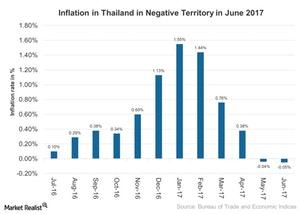Is Negative Inflation Suggesting Contraction in Thailand in 2017?
Thailand’s (EEM) inflation in June 2017 exceeded the market estimate of a 0.1% drop.
July 17 2017, Updated 7:40 a.m. ET

Inflation in Thailand
Price pressures continue to remain low in Thailand (THD) even after a decent pick up in economic activity in 1Q17. Consumer prices in Thailand dropped 0.05% on a year-over-year basis in June 2017 as compared to a 0.04% decline in the previous month. The slump in oil (DBO) prices in 2017 seems to again be affecting inflationary pressures in Thailand as of June 2017. Let’s look at the inflationary trends in Thailand over the last year in the below chart.
Inflation in June 2017
Thailand’s (EEM) inflation in June 2017 exceeded the market estimate of a 0.1% drop. The prices of food and beverages fell further by 0.70% in June 2017 as compared to a 1.4% decline in May 2017. The prices of non-food items increased at a slower pace of 0.32% in June as compared to 0.74% in May 2017. Core consumer prices, which exclude volatile items like food and energy prices, rose 0.45% as compared to 0.46% in the previous month and were within expectations. The supply-side factors continue to keep inflation at low levels in 2017 and are expected to do so for some time in the future, according to the Central Bank of Thailand.
Accommodative monetary policy in 2017
Recently, the Bank of Thailand (ASEA) left its benchmark policy rate unchanged at 1.5% on July 5, 2017, in line with market expectations. According to policymakers in Thailand, the growth outlook for 2017 has improved due to recovery in exports. However, the growth in domestic demand is still slower resulting in inflation at low levels in 2017.
Expectations
The Bank of Thailand (EEMA) expects growth to improve further in 2017 due to improved export outlook and gradual expansion in domestic demand. The current negative inflation is expected to be temporary amid the oil price slump and supply-side factors.
The headline inflation (TIP), which includes volatile items like food and energy (XLE), is expected to gradually rise in the latter half of 2017. The improved growth expectations are attributed to expansion in exports and recovery in tourism in 2017. However, uncertainties related to trade policies in developed markets like the US (SPY) are expected to affect the export-oriented economy of Thailand (EEM).
Let’s look at the trade balance of Thailand in our next article.
